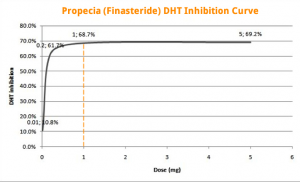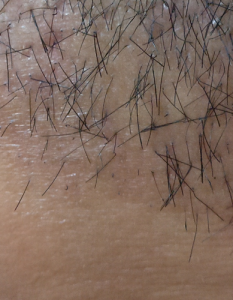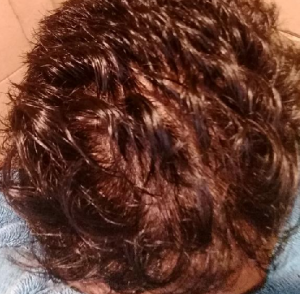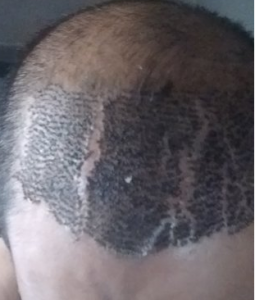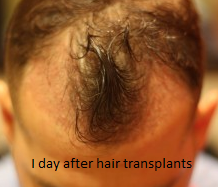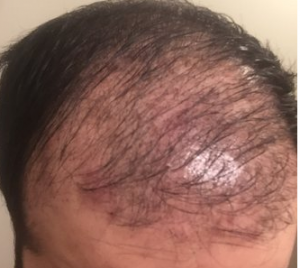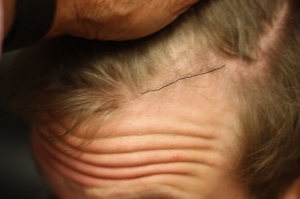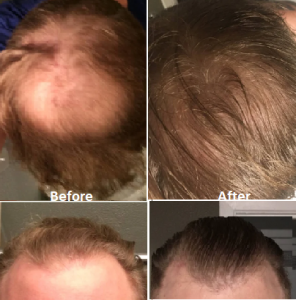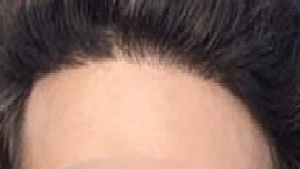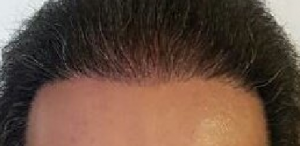Probably not. What I see is that you appear in the front to be transitioning into a male mature hairline as the widow’s peak is a remnant to where your hairline receded as it is moving to a mature hairline. Some men retain this widow’s peak unless they undergo genetic balding in which case they may lose the widow’s peak and the entire hairline as well. It appears that your left side is maturing faster than your right side.
I was thinking about shaving my head but I heard that if I do, it will prevent my hair from growing back. Is this really true?
If your hair has significant miniaturization with hairs that are not growing at this time, then these hairs may not grow back if they are now growing now. Advanced miniaturization of the hairs is often the end stage of hair loss. Other parts of your scalp where there is not end stage miniaturization, will grow back normally. Hairs in the early phase of miniaturization, grow slower than those hairs that are not miniaturized.
I developed an infection and met with my doctor who put me on antibiotics. It seemed to get better. I am worried about it harming the grafts in the recipient area. Is that a problem?
It is hard to tell from the pictures if the infection is under control but your doctor will tell you that and you should see no significant pimples or redness. If the infection was promptly treated, it will not harm the grafts. The good news is I see early growth already.
This is a 17 year old with a family history of advanced balding. He is seeing some hair in the shower and is frightened abut what his future holds for him. The question is reasonable and is best answered with a HAIRCHECK TEST with an instrument that some doctors have in their offices. This is an accurate way to answer this young man’s question as seen in this previous patient: https://baldingblog.com/2017/01/10/value-haircheck-bulk-measurements-two-patients-seen-today/
Here is a picture of the 17 year old who asked the question. His picture is similar to the example I showed above in the link I supplied.
I found this link on Reddit which is an excellent review of the entire microneedling process which I have been asked about often:
https://www.reddit.com/r/tressless/wiki/microneedling
Yeah I’m not dealing with this. Life already sucks to go through right now. I’m not sure which treatment I want to do. Surgery is too expensive. The libido sides from finasteride and minoxidil aren’t really an issue for me but it’s still a bit iffy. What do you suggest is the best course of action? I’m already not a looker
I doubt that your hairline is receding. Sometimes the mature hairline appears at your age and that maybe all it is. Send me photos and I will give you an opinion but be sure that your photo has your full face with your eyebrows lifted so that the forehead creases. A mature hairline is one finger breadth above the highest crease of the furrowed brow., see here: https://baldingblog.com/mature-hairline-photo/
Diffuse thinning may or may not be uniform thinning. See the distinction in a recent commentary I published in the HT Forum: https://newhair.com/pdf/Kumaresan-Muthuvel-Bernstein-Rassman-Commentary.pdf You need to see magnified views of your hair in different parts of your scalp. By going to Amazon, look for hand microscopes and for under $50 you can get good digital photos of your scalp at the hair roots. Then get a map of the head from Google, label each area you photo (a, b, c, etc) and then send them to me and I will look at them and give you a diagnosis. Be sure to include your donor area from the back of your head.
I saw this photo on an internet site where the patient asked how his recipient area looked and why the cracks where there. Clearly the doctor never told the patient how to take care of the recipient area. This poor man will have to walk around for almost a month with this ‘cake’ on his head and he will not be able to go out in public without a hat on his head. Compare the patient with the caked crusts to one of our patients who had proper washing (on the right). Below is our washing process for readers who do not want to get cake on their head.
Post Operative Recipient Site Care: An FUE is treated just like a regular hair transplant with regard to the recipient area, but the donor area has open wounds which require daily washing with soap and water. There should be no crusts present even on day one if the washing routine below is followed. Within 3 days of surgery, you can resume full activities, heavy exercises if you wish. The recipient area requires daily washes as well to keep the recipient area free of crusts. I generally recommend the use of a sponge and supply my patient with a surgical sponge to fill with soapy water and press on the recipient area daily. By repeating this daily, all crusts can be washed off without any fear of losing grafts. IF any crust are present, use a Q tip and dip it into soapy water, and roll it on the crusts and that will lift them off without dislodging them, but never rub them, just roll the Q tip on the recipient crust. I like to see no evidence of any crusting in the recipient area and the crusts from the donor area gone in 7-10 days with daily washing
It has been 2 months since the hair transplant and now I have pus all over the graft area. What shall I do? Will it harm my hair transplant? I live in New York and went to Turkey for the transplant so my doctor can’t see me unless I fly back there.
Yes, pus throughout the recipient area is a problem and it can harm your eventual graft growth. With your doctor out of the country and inaccessible, you should find a local hair transplant doctor or a local dermatologist to get it treated ASAP. After an examination and a culture of the pus, the doctor will treat it with an appropriate antibiotic.
I have always assumed that a male will not recede from genetic balding without some hair loss somewhere on the scalp. This patient has challenged me as I hold this concept. I believe that both the frontal forelock (in some people) and the juvenile hairline in all men, have a different genetic makeup with regard holding on to their hair. I have seen men who have kept a fully intact juvenile hairline and become a full Class 7 pattern of balding, and to me that proves this concept. The concept that a persistent frontal forelock remains as the corners recede is common and all of us have seen this. This 22 year old male is different because I have been following him before the juvenile hairline disappeared. I believe the corners of this line are now receding. Here is the letter I sent to him as well as a series of experts in the field of hair restoration for opinions on my question.
Good to see you today. We repeated your HAIRCHECK measurements today which we have performed on numerous times over the past couple of years. This instrument continue to report no balding evident which means that there is no detectable hair loss behind the frontal hairline. Despite this, you have now what appears to be some mild recession, but considering that you have a persistent frontal forelock, this may be an illusion and you could be developing a maturing hairline in the corners as there is no hair loss in the mid-line where the persistent frontal forelock is present. Notice the faint line I drew at the leading edge of your hairline, which takes into account the persistent frontal forelock and a location where I think a mature hairline belongs. This is where your hairline actually belongs. It does appear that you have some early erosion of this leading edge of the hairline.
The question we discussed is: What is the timing of finasteride? If you take it now, you will be locked into it for the rest of your life. IF you do have balding, then at some point decide to stop the drug which may have been holding the hair on your head, then you will develop catch-up hair loss. If you hold off starting the drug and come back in a year, it may become more apparent what you diagnosis is. We both decided to wait another year, repeat the HAIRCHECK test at that time, reassess your frontal hairline when compared to the photos we took today, and then take another assessment if finasteride is appropriate for you.
Question: Can frontal recession occur without any evidence of miniaturization or hair loss elsewhere on the head of a male.
Answer: Yes, recession in some men can be independent of miniaturization and hair loss behind the hairline.
I have had 3 consultations and each one told me that I needed a different number of grafts. One doctor quoted 4000 grafts, another 3500 grafts and a third 3000 grafts. It is very confusing. My hair is a medium weight hair (I know you always ask) so I am asking you what you think I need for grafts.
Too many doctors or clinics push up the number of grafts well beyond what you need. With a medium weight hair, I doubt that you will need more than 2000 grafts to lower the hairline and bring the corners down. The reason that the numbers you heard were high is because too many doctor think about grafts as $$ in their pocket, more grafts more $$ for them. For the patient like you, too many grafts deplete your permanent hair supply and if you found yourself balding as you got older and did 4000 grafts for the front now, you might find yourself without any hair reserves for future balding.
I am a 34 year old male, what do you think of my hairline?
The hairline should be V-Shaped as this is a typical hairline in a Caucasian male whose hairline has matured (bottom photos). Unfortunately, your surgeon gave you a rounded female hairline by shape, The leading edge of the hairline should have a transition zone in front of the two and three hair grafts so that there is no visible hairline present (the three last photos), just a zone from the forehead to the thicker hair. You have no such zone. Compare your hairline on the left with the three photos at the bottom of the window. This is a typical mature male hairline which has a better shape to it. In all of our patients we create a transition zone in the front of the two and three hair grafts as as shown in the three pictures at the bottom which demonstrates a ‘no-hairline hairline’.
Page 210 of 1247



